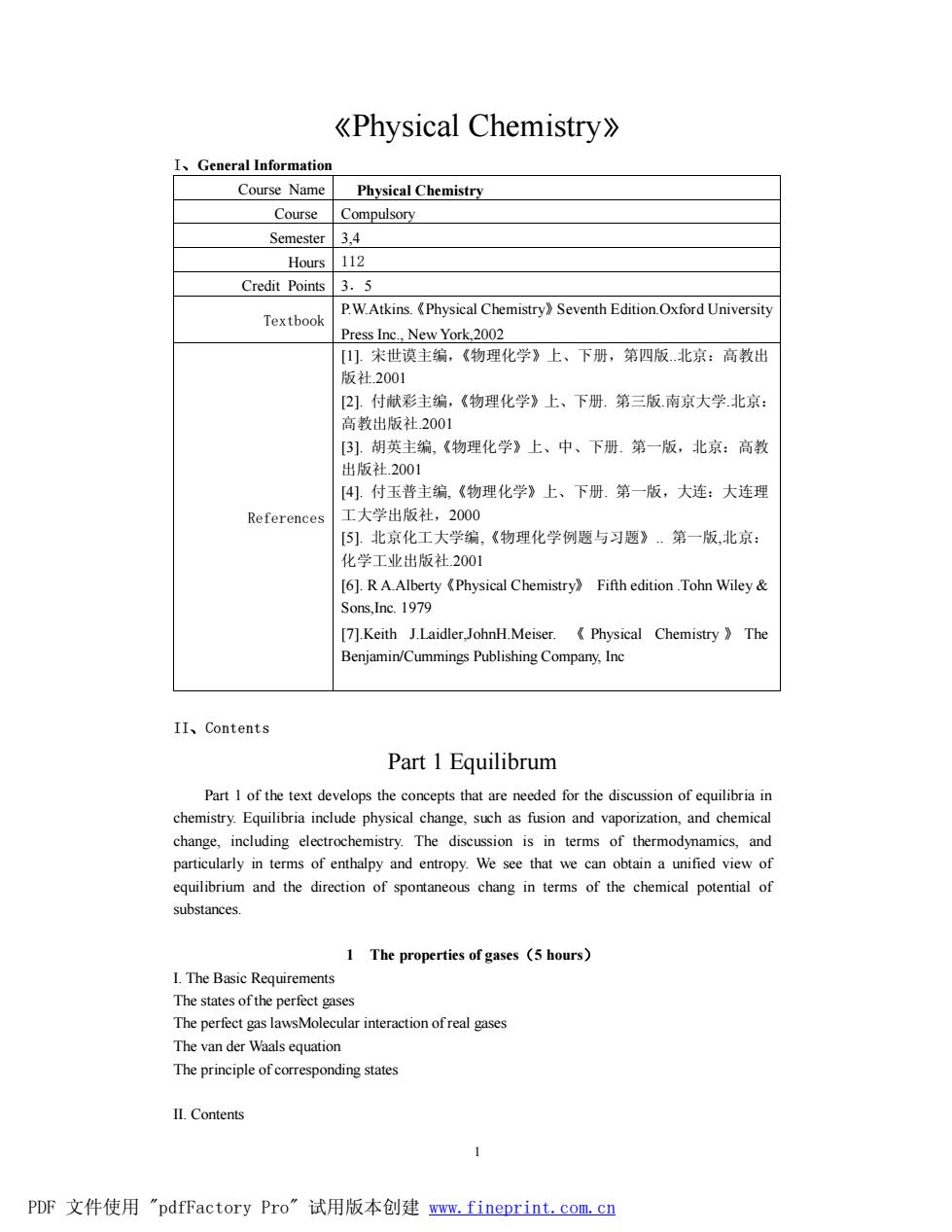
Physical Chemistry》 I,General Information Course Name Physical Chemistry Course ompulsory Semester Hours 112 Credit Points3.5 PWAtkinsPhysical Chemistry Seventh Edition.Oxford University 价宋世谟主编《物理化学》上、下所,第四版北京:高教出】 s In 002 [2】.付献彩主编,《物理化学》上、下册.第三版南京大学北京: 高教出版社.2001 [31.胡英主编,《物理化学》上、中、下册.第一版,北京:高教 出版社.2001 [4付玉普主编,《物理化学》上、下册,第一版,大连:大连理 References 大学出服补,2000 [5北京化工大学编,《物理化学例题与习》…第一版,北京 化学工业出版社.2001 [6].RA.Alberty (Physical Chemistry?Fifth edition.Tohn Wiley Sons Inc.1979 [7]Keith J.Laidler JohnH.Meiser.Physical Chemistry The njamin/Cummings Publishing Company,Ine II、Contents Part 1 Equilibrum istry ange ,such as fiusio nd va nd cher change,including electroc The discussion is in terms of thermodynamics,and particularly in terms of enthalpy and entropy.We see that we can obtain a unified view of equilibrium and the direction of spontaneous chang in terms of the chemical potential of substances. 1 The properties of gases (5 hours) 1.The Basic Requirements The tates of the r TieperfetgaslasMolceriniteractionofrelgascg The van der Waals equation The principle of corresponding states II.Contents PDF文件使用"pdfFactory Pro”试用版本创建,fineprint.com,cn
1 《Physical Chemistry》 I、General Information Course Name Physical Chemistry Course Compulsory Semester 3,4 Hours 112 Credit Points 3.5 Textbook P.W.Atkins.《Physical Chemistry》Seventh Edition.Oxford University Press Inc., New York,2002 References [1]. 宋世谟主编,《物理化学》上、下册,第四版..北京:高教出 版社.2001 [2]. 付献彩主编,《物理化学》上、下册. 第三版.南京大学.北京: 高教出版社.2001 [3]. 胡英主编,《物理化学》上、中、下册. 第一版,北京:高教 出版社.2001 [4]. 付玉普主编,《物理化学》上、下册. 第一版,大连:大连理 工大学出版社,2000 [5]. 北京化工大学编,《物理化学例题与习题》.. 第一版,北京: 化学工业出版社.2001 [6]. R A.Alberty《Physical Chemistry》 Fifth edition .Tohn Wiley & Sons,Inc. 1979 [7].Keith J.Laidler,JohnH.Meiser. 《 Physical Chemistry 》 The Benjamin/Cummings Publishing Company, Inc II、Contents Part 1 Equilibrum Part 1 of the text develops the concepts that are needed for the discussion of equilibria in chemistry. Equilibria include physical change, such as fusion and vaporization, and chemical change, including electrochemistry. The discussion is in terms of thermodynamics, and particularly in terms of enthalpy and entropy. We see that we can obtain a unified view of equilibrium and the direction of spontaneous chang in terms of the chemical potential of substances. 1 The properties of gases(5 hours) I. The Basic Requirements The states of the perfect gases The perfect gas lawsMolecular interaction of real gases The van der Waals equation The principle of corresponding states II. Contents PDF 文件使用 "pdfFactory Pro" 试用版本创建 www.fineprint.com.cn
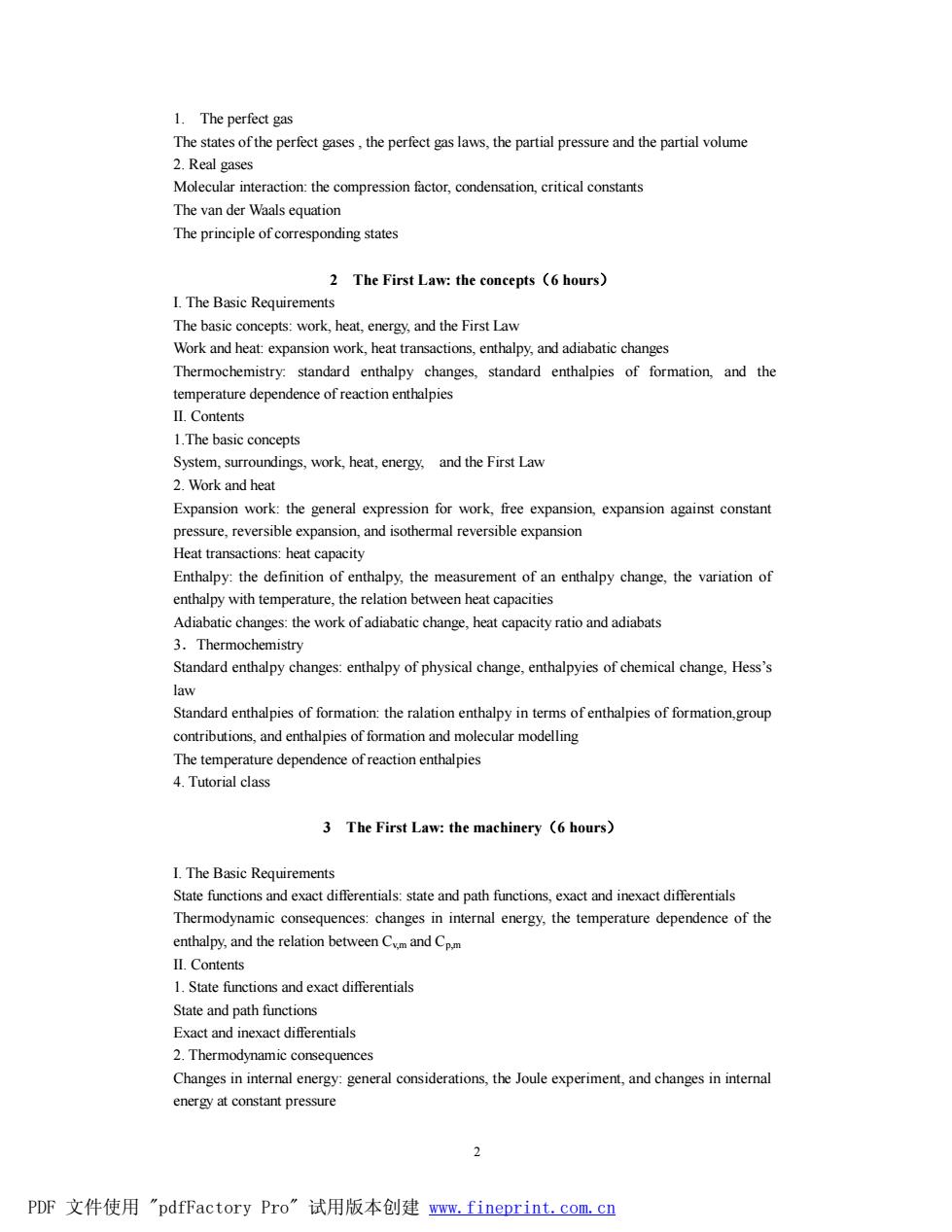
1.The perfect gas The states of the perfect gases,the perfect gas laws,the partial pressure and the partial volum 2.Real gases Molecular interaction:the compression factor,condensation,critical constants The van der Waals equation The principle of corresponding states 2 The First Law:the concepts (6 hours) I.The Basic Requirements The basic concepts:work,heat,energy,and the First Law Work and heat:expansion work.heat transactions.enthalpy.and adiabatic changes Thermochemistry. standard enthalpy changes,standard enthalpies of formation,and the temperature II.Contents 1.The basic concepts System,surroundings,work,heat,energy,and the First Law 2 Work and heat Expansion work:the general expression for work.free expansion expansion against constan pressure,reversible expansion,and isothermal reversible expansion Heat transactions:heat capacity Enthalpy:the definition of enthalpy,the measurement of an enthalpy change,the variation of enthalpy with temperature.the relation between heat capacities Adiabatic changes:the work of adiabatic change heat capacity ratio and adiabats Thermo Standard enthalpy changes:enthalpy of physical change,enthalpyies of chemical change,Hess's law Standard enthalpies of formation:the ralation enthalpy in terms of enthalpies of formation,group contributions,and enthalpies of formation and molecular modelling The temperature 4.Tutorial clas 3 The First Law:the machinery (6 hours) I The basic requirements State fiunction Thermodynamic consequences:changes in internal energy.the temperature dependence of the enthalpy,and the relation between Cmand Cpm II Contents 1.State functions and exact differentials State and path fiunctions Exactand 2.Thermodynamic consequences Changes in internal energy:general considerations,the Joule experiment,and changes in internal energy at constant pressure 2 PDF文件使用"pdfFactory Pro”试用版本创建n,fineprint,com,cn
2 1. The perfect gas The states of the perfect gases , the perfect gas laws, the partial pressure and the partial volume 2. Real gases Molecular interaction: the compression factor, condensation, critical constants The van der Waals equation The principle of corresponding states 2 The First Law: the concepts(6 hours) I. The Basic Requirements The basic concepts: work, heat, energy, and the First Law Work and heat: expansion work, heat transactions, enthalpy, and adiabatic changes Thermochemistry: standard enthalpy changes, standard enthalpies of formation, and the temperature dependence of reaction enthalpies II. Contents 1.The basic concepts System, surroundings, work, heat, energy, and the First Law 2. Work and heat Expansion work: the general expression for work, free expansion, expansion against constant pressure, reversible expansion, and isothermal reversible expansion Heat transactions: heat capacity Enthalpy: the definition of enthalpy, the measurement of an enthalpy change, the variation of enthalpy with temperature, the relation between heat capacities Adiabatic changes: the work of adiabatic change, heat capacity ratio and adiabats 3.Thermochemistry Standard enthalpy changes: enthalpy of physical change, enthalpyies of chemical change, Hess’s law Standard enthalpies of formation: the ralation enthalpy in terms of enthalpies of formation,group contributions, and enthalpies of formation and molecular modelling The temperature dependence of reaction enthalpies 4. Tutorial class 3 The First Law: the machinery(6 hours) I. The Basic Requirements State functions and exact differentials: state and path functions, exact and inexact differentials Thermodynamic consequences: changes in internal energy, the temperature dependence of the enthalpy, and the relation between Cv,m and Cp,m II. Contents 1. State functions and exact differentials State and path functions Exact and inexact differentials 2. Thermodynamic consequences Changes in internal energy: general considerations, the Joule experiment, and changes in internal energy at constant pressure PDF 文件使用 "pdfFactory Pro" 试用版本创建 www.fineprint.com.cn
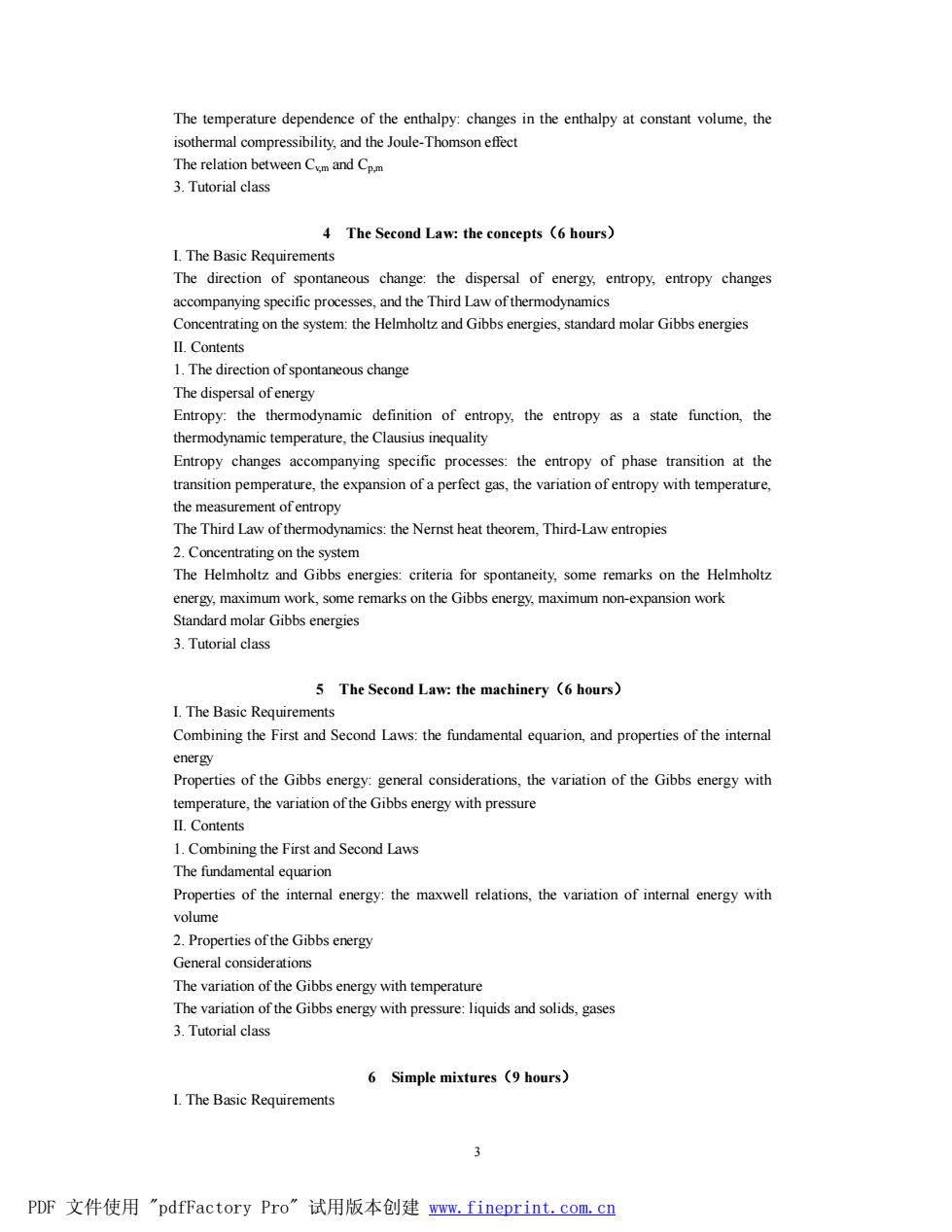
The temperature dependence of the enthalpy:changes in the enthalpy at constant volume,the isothermal compressibility.and the Joule-Thomsoneffec The relation between Cm and Cm 3.Tutorial class 4 The Second Law:the concepts (6 hours) I.The Basic Requirements The direction of spontaneous change:the dispersal of energy,entropy,entropy changes accompanying specific processes,and the Third Law ofthermodynamics Concentrating on the system:the Helmholtz and Gibbs energies,standard molar Gibbs energies IL Contents The dispersal of energy Entropy:the thermodynamic definition of entropy,the entropy as a state function,the thermodynamic temperature.the Clausius inequality Entropy changes accompanying specific processes:the entropy of phase transition at the ransition pemperature,the n of a perfect gas,the variatio of entropy with temperature the mea asurement of entropy The Third Law ofthermodynamics:the Nernst heat theorem,Third-Law entropies 2.Concentrating on the system The Helmholtz and Gibbs energies:criteria for spontaneity,some remarks on the Helmholtz energy.maximum work,some remarks on the Gibbs energy.maximum non-expansion work dard molar Gibbs energie 3.Tutorial clas 5 The Second Law:the machinery (6 hours) I.The Basic Requirements Combining the First and Second Laws:the fundamental equarion,and properties of the interal energy Properties of the Gibbs energy:general considerations,the variation of the Gibbs energy with temperature,the variation of the Gibbs energy with pressure II.Contents 1.Combining the First and Second Laws The fundan Properties of the interal energy:the maxwell relations,the variation of interal energy with volume 2.Properties of the Gibbs energy General considerations The variation of the Gibbs temper ure ofthe Gibbs energy with pressure:liquids and solids,gases 3.Tutorial class 6 Simple mixtures (9 hours) 1.The Basic Requirements 3 PDF文件使用"pdfFactory Pro”试用版本创建ww,fineprint.com,cn
3 The temperature dependence of the enthalpy: changes in the enthalpy at constant volume, the isothermal compressibility, and the Joule-Thomson effect The relation between Cv,m and Cp,m 3. Tutorial class 4 The Second Law: the concepts(6 hours) I. The Basic Requirements The direction of spontaneous change: the dispersal of energy, entropy, entropy changes accompanying specific processes, and the Third Law of thermodynamics Concentrating on the system: the Helmholtz and Gibbs energies, standard molar Gibbs energies II. Contents 1. The direction of spontaneous change The dispersal of energy Entropy: the thermodynamic definition of entropy, the entropy as a state function, the thermodynamic temperature, the Clausius inequality Entropy changes accompanying specific processes: the entropy of phase transition at the transition pemperature, the expansion of a perfect gas, the variation of entropy with temperature, the measurement of entropy The Third Law of thermodynamics: the Nernst heat theorem, Third-Law entropies 2. Concentrating on the system The Helmholtz and Gibbs energies: criteria for spontaneity, some remarks on the Helmholtz energy, maximum work, some remarks on the Gibbs energy, maximum non-expansion work Standard molar Gibbs energies 3. Tutorial class 5 The Second Law: the machinery(6 hours) I. The Basic Requirements Combining the First and Second Laws: the fundamental equarion, and properties of the internal energy Properties of the Gibbs energy: general considerations, the variation of the Gibbs energy with temperature, the variation of the Gibbs energy with pressure II. Contents 1. Combining the First and Second Laws The fundamental equarion Properties of the internal energy: the maxwell relations, the variation of internal energy with volume 2. Properties of the Gibbs energy General considerations The variation of the Gibbs energy with temperature The variation of the Gibbs energy with pressure: liquids and solids, gases 3. Tutorial class 6 Simple mixtures(9 hours) I. The Basic Requirements PDF 文件使用 "pdfFactory Pro" 试用版本创建 www.fineprint.com.cn
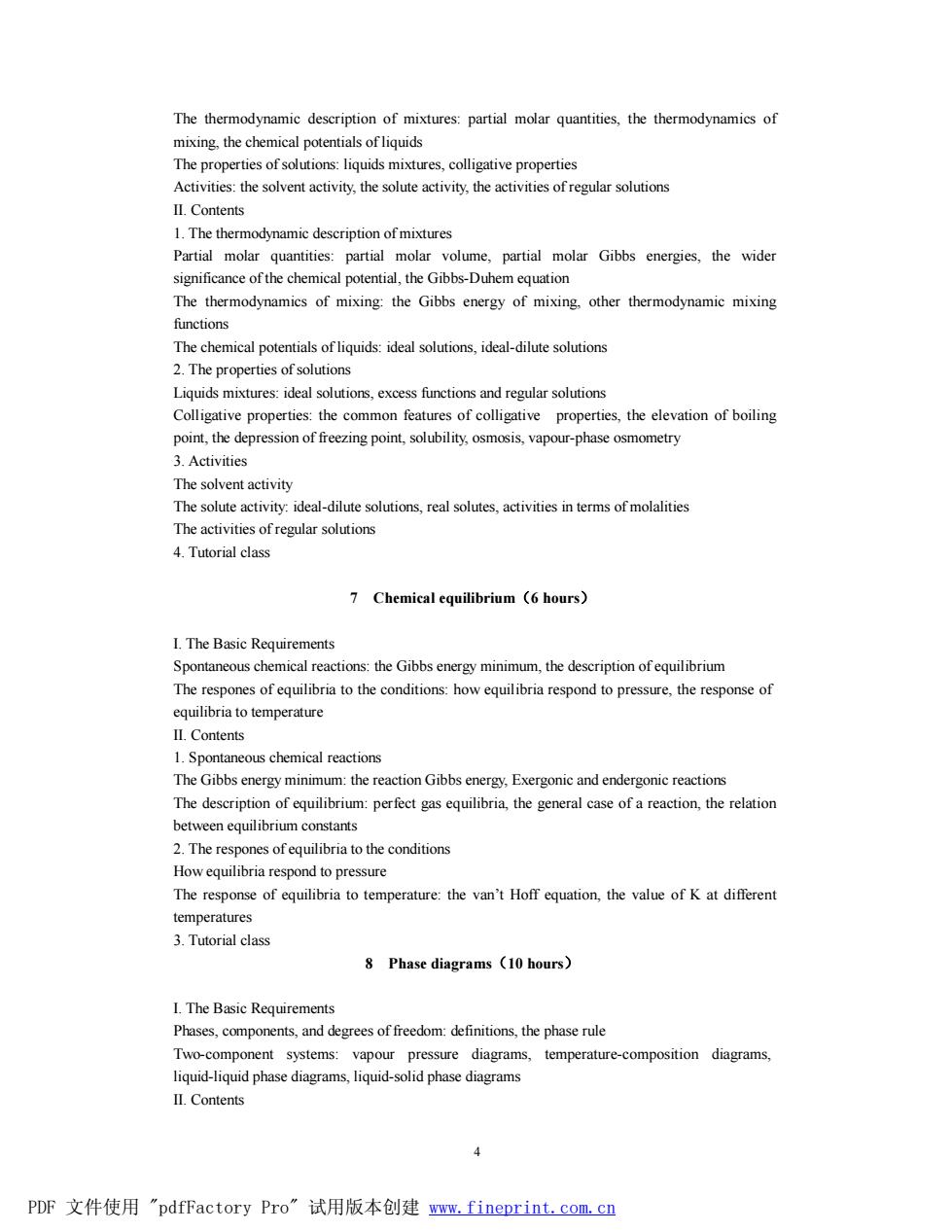
The thermodynamic description of mixtures:partial molar quantities,the thermodynamics of Activities:the solvent activity,the solute activity,the activities of regular solutions II.Contents 1.The thermodynamic description of mixtures partial molar volume,partial molar bb the wider nical entia the Gibbs-Duhemo The thermodynamics of mixing:the Gibbs energy of mixing.other thermodynamic mixing functions The chemical potentials of liquids:ideal solutions,ideal-dilute solutions 2.The properties of solutions Liquidsmitresidcealsolutios,cxcesfrnctosamdregularsoltions properties:thecommo features of,of boiing point,the depression of freezing point,solubility,osmosis,vapour-phase osmometry 3.Activities The solvent activity The solute activity:ideal-dilute solutions,real solutes,activities in terms of molalities 4.Tutorial class 7 Chemical equilibrium (6 hours) 1.The Basic Requirements Spontaneous chemical the Gbbs energy minimum,the description The respones ofequlibria to the conditions:how equilibria respond to pressure,the response of equilibria to temperature II.Contents 1.Spontaneous chemical The Gibbs nergy minimum:the enery Exergonic and endergon The description of equilibrium:perfect gas equilibria,the general case of a reaction,the relation between equilibrium constants 2.The respones ofequilibria to the conditions How equilibria respond to pressure The response of quilibria to temperature:the van't Hoff quation,the value of K at differen 3.Tutorial class 8 Phase diagrams (10 hours) I The basic requirements Phases.degrees of freedm:finitions,the phase rule Two-component systems:vapour pressure diagrams.temperature-composition diagrams. liquid-liquid phase diagrams,liquid-solid phase diagrams II.Contents PDF文件使用"pdfFactory Pro”试用版本创建n,fineprint,com,cn
4 The thermodynamic description of mixtures: partial molar quantities, the thermodynamics of mixing, the chemical potentials of liquids The properties of solutions: liquids mixtures, colligative properties Activities: the solvent activity, the solute activity, the activities of regular solutions II. Contents 1. The thermodynamic description of mixtures Partial molar quantities: partial molar volume, partial molar Gibbs energies, the wider significance of the chemical potential, the Gibbs-Duhem equation The thermodynamics of mixing: the Gibbs energy of mixing, other thermodynamic mixing functions The chemical potentials of liquids: ideal solutions, ideal-dilute solutions 2. The properties of solutions Liquids mixtures: ideal solutions, excess functions and regular solutions Colligative properties: the common features of colligative properties, the elevation of boiling point, the depression of freezing point, solubility, osmosis, vapour-phase osmometry 3. Activities The solvent activity The solute activity: ideal-dilute solutions, real solutes, activities in terms of molalities The activities of regular solutions 4. Tutorial class 7 Chemical equilibrium(6 hours) I. The Basic Requirements Spontaneous chemical reactions: the Gibbs energy minimum, the description of equilibrium The respones of equilibria to the conditions: how equilibria respond to pressure, the response of equilibria to temperature II. Contents 1. Spontaneous chemical reactions The Gibbs energy minimum: the reaction Gibbs energy, Exergonic and endergonic reactions The description of equilibrium: perfect gas equilibria, the general case of a reaction, the relation between equilibrium constants 2. The respones of equilibria to the conditions How equilibria respond to pressure The response of equilibria to temperature: the van’t Hoff equation, the value of K at different temperatures 3. Tutorial class 8 Phase diagrams(10 hours) I. The Basic Requirements Phases, components, and degrees of freedom: definitions, the phase rule Two-component systems: vapour pressure diagrams, temperature-composition diagrams, liquid-liquid phase diagrams, liquid-solid phase diagrams II. Contents PDF 文件使用 "pdfFactory Pro" 试用版本创建 www.fineprint.com.cn
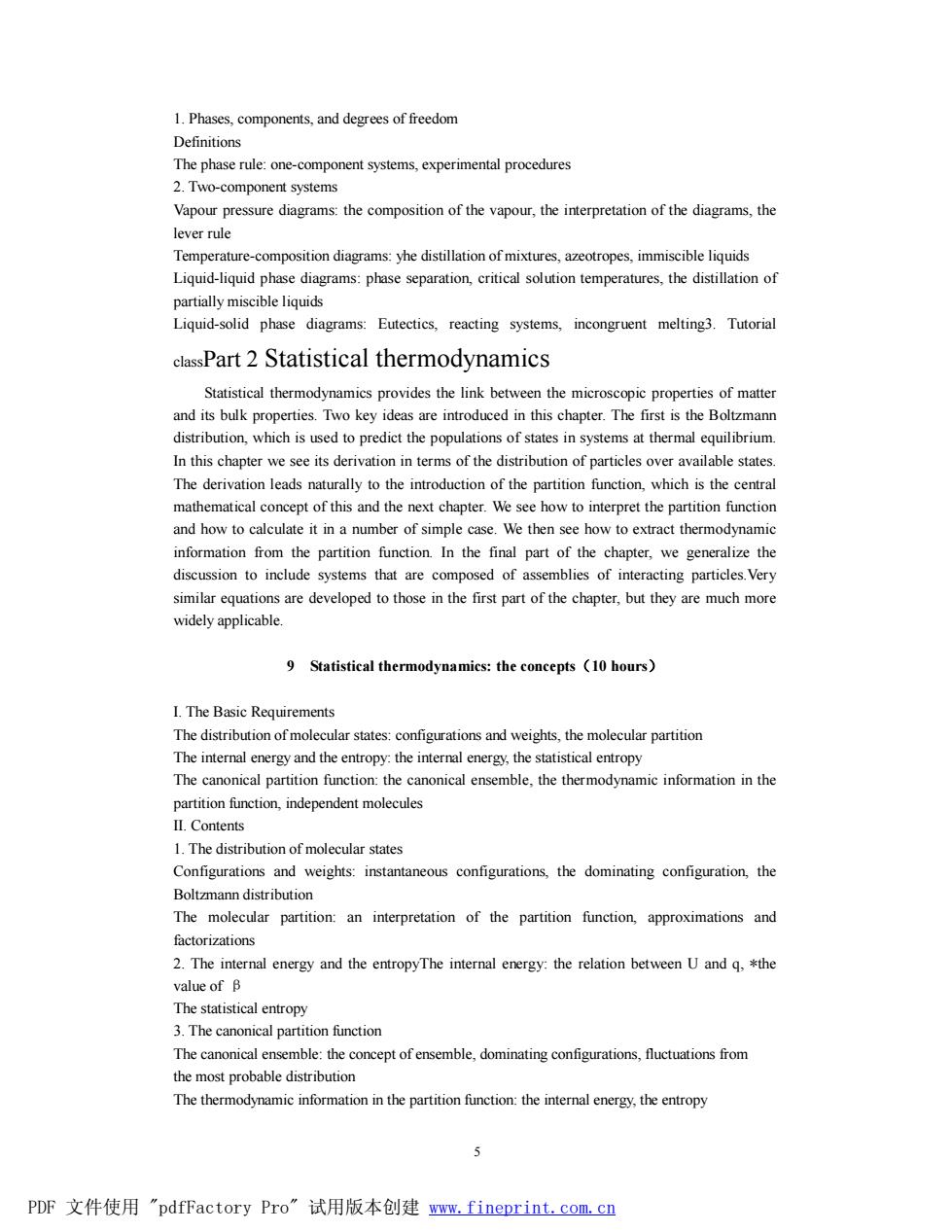
1.Phases,components.and degrees of freedom Definitions The phase rule:one-component systems,experimental procedures 2.Two-component systems Vapour pressure diagrams:the composition of the vapour.the interpretation of the diagrams.the lever rule Liquid-liquid phase diagrams:phase separation,critical solution temperatures,the distillation of partially miscible liquids Liquid-solid phase diagrams:Eutectics,reacting systems,incongruent melting3.Tutorial elassPart 2 Statistical thermodynamics Statistical thermodynamics provides the link between the microscopic properties of matter and its bulk properties.Two key ideas are introduced in this chapter.The first is the Boltzmann distribution,which is used to predict the populations of states in systems at thermal equilibrium. In this chapter we see its derivation in terms of the distribution of particles over available states The erivation leads naturally to the introduction of the parttion which is the ce mathematical concept of this and the next chapter.We see how to interpret the partition fiuncti and how to calculate it in a number of simple case.We then see how to extract thermodynamic information from the partition function.In the final part of the chapter,we generalize the discussion to include systems that are composed of assemblies of interacting particles.Very similar equations are developed to those in the first part of the chapter,but they are much more widelyapplicable. 9 Statistical thermodynamics:the concepts (10 hours) I.The Basic Requirements he st The canonical partition function:the canonical ensemble,the thermodynamic information in the partition function,independent molecules IL Contents 1.The distribution of molecular states and weights: instantaneous configurations,the dominating configuration,the Boltzmann distribution The molecular partition:an interpretation of the partition function,approximations and factorizations 2.The internal energy and the entropyThe internal energy:the relation between U and q,*the value of B 3.The canonical partition function The canonical ensemble:the concept of ensemble.dominating configurations,fluctuations from the most probable distribution The thermodynamic information in the partition function:the internal energy,the entropy PDF文件使用"pdfFactory Pro”试用版本创建ww,fineprint.com,cn
5 1. Phases, components, and degrees of freedom Definitions The phase rule: one-component systems, experimental procedures 2. Two-component systems Vapour pressure diagrams: the composition of the vapour, the interpretation of the diagrams, the lever rule Temperature-composition diagrams: yhe distillation of mixtures, azeotropes, immiscible liquids Liquid-liquid phase diagrams: phase separation, critical solution temperatures, the distillation of partially miscible liquids Liquid-solid phase diagrams: Eutectics, reacting systems, incongruent melting3. Tutorial classPart 2 Statistical thermodynamics Statistical thermodynamics provides the link between the microscopic properties of matter and its bulk properties. Two key ideas are introduced in this chapter. The first is the Boltzmann distribution, which is used to predict the populations of states in systems at thermal equilibrium. In this chapter we see its derivation in terms of the distribution of particles over available states. The derivation leads naturally to the introduction of the partition function, which is the central mathematical concept of this and the next chapter. We see how to interpret the partition function and how to calculate it in a number of simple case. We then see how to extract thermodynamic information from the partition function. In the final part of the chapter, we generalize the discussion to include systems that are composed of assemblies of interacting particles.Very similar equations are developed to those in the first part of the chapter, but they are much more widely applicable. 9 Statistical thermodynamics: the concepts(10 hours) I. The Basic Requirements The distribution of molecular states: configurations and weights, the molecular partition The internal energy and the entropy: the internal energy, the statistical entropy The canonical partition function: the canonical ensemble, the thermodynamic information in the partition function, independent molecules II. Contents 1. The distribution of molecular states Configurations and weights: instantaneous configurations, the dominating configuration, the Boltzmann distribution The molecular partition: an interpretation of the partition function, approximations and factorizations 2. The internal energy and the entropyThe internal energy: the relation between U and q, *the value of β The statistical entropy 3. The canonical partition function The canonical ensemble: the concept of ensemble, dominating configurations, fluctuations from the most probable distribution The thermodynamic information in the partition function: the internal energy, the entropy PDF 文件使用 "pdfFactory Pro" 试用版本创建 www.fineprint.com.cn